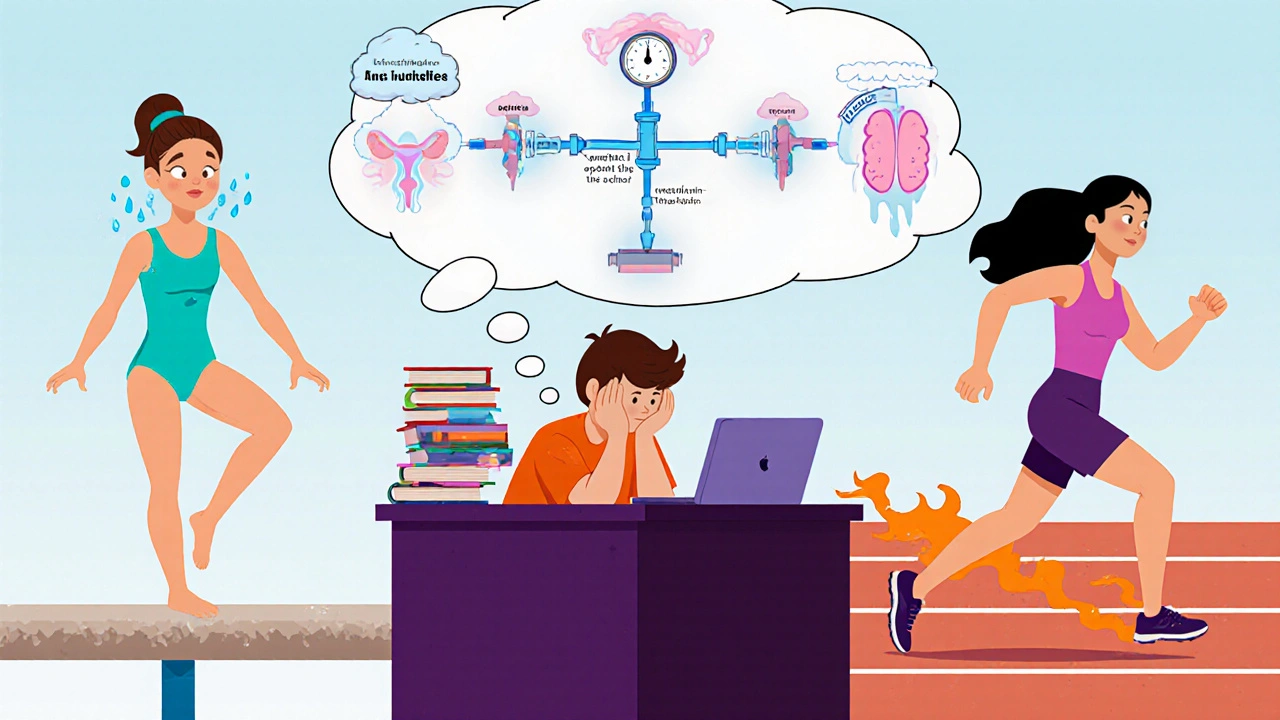Amenorrhea Risk Assessment Tool
This tool helps you understand your risk of developing amenorrhea based on key lifestyle factors. It's designed to help teens and young women identify when to seek medical attention. Remember, this is not a diagnostic tool but a general risk assessment.
Quick Takeaways
- Missing periods for three+ months in teens signals amenorrhea and needs medical review.
- Common triggers include low body weight, intense exercise, stress, and hormonal disorders.
- Long‑term risks are low bone density, reduced fertility, anemia, and mood issues.
- Early diagnosis, balanced nutrition, moderated activity, and targeted therapy can reverse most cases.
- Regular follow‑up with a GP or specialist is essential to prevent lasting damage.
What Is Amenamenorrhea?
When the menstrual cycle stops for three or more consecutive months in someone who previously had regular periods, doctors call it Amenorrhea the absence of menstrual bleeding beyond the expected timeframe. It can be a sign of an underlying health issue, not just a harmless hiccup.
Why Adolescents and Young Women Are Especially Vulnerable
Girls between ages 12 and 19 experience rapid hormonal changes, growth spurts, and shifting body composition. Their bodies are still fine‑tuning the feedback loop between the hypothalamus, pituitary gland, and ovaries. Any disturbance-whether nutritional, psychological, or physical-can tip that balance and shut down periods.
According to a 2023 UK adolescent health survey, about 7 % of 15‑ to 18‑year‑olds reported missing periods for at least three months, a figure that climbs to 12 % among competitive athletes.
Primary vs. Secondary Amenorrhea
| Aspect | Primary Amenorrhea | Secondary Amenorrhea |
|---|---|---|
| When it starts | No periods by age 15‑16 despite normal growth | Previously regular cycles that stop later |
| Typical causes | Genetic anomalies, congenital uterine issues | Weight loss, intense training, stress, hormonal disorders |
| Diagnostic focus | Chromosomal analysis, imaging of reproductive organs | Hormone panels, nutrition assessment, lifestyle review |
| Long‑term concerns | Fertility challenges, delayed puberty | Bone loss, infertility if untreated |

Common Triggers in Teens and Young Women
Below are the most frequent culprits, each linked to a specific physiological pathway.
- Low body weight often seen in eating disorders or strict dieting. Fat stores produce leptin, a hormone that signals the brain that energy reserves are sufficient for reproduction. When leptin drops, the hypothalamus tells the pituitary to pause ovulation.
- Excessive exercise common among endurance athletes, dancers, and gymnasts. High training loads raise cortisol and lower estrogen, leading to exercise‑induced amenorrhea.
- Stress academic pressure, family conflict, or mental health struggles. Chronic stress spikes cortisol, which interferes with GnRH release.
- Polycystic Ovary Syndrome (PCOS) characterized by excess androgen production and irregular cycles. In adolescents, PCOS can manifest as periods that become increasingly spaced before stopping.
- Thyroid dysfunction both hyper‑ and hypothyroidism can disrupt menstrual regularity.
- Medications certain hormonal contraceptives, antipsychotics, or chemotherapy agents.
Health Risks of Prolonged Amenorrhea
When periods stop, the ovaries produce less estrogen, a hormone that does more than regulate the cycle. It also protects bones, supports cardiovascular health, and influences mood.
Bone health - the silent threat
Osteoporosis low bone mineral density that increases fracture risk can begin in the teen years. Studies from the British Society for Bone Research show that girls with amenorrhea for over a year have a 30 % reduction in bone mineral density compared with peers.
Fertility concerns
Without regular ovulation, the chance of conceiving naturally drops sharply. Even if periods return later, the cumulative exposure to low estrogen may affect ovarian reserve.
Anemia and nutrient deficiencies
Iron‑deficiency anemia often co‑exists with restrictive eating patterns that also trigger amenorrhea. Low iron further reduces stamina and cognitive performance, creating a vicious cycle.
Mental health impact
Missing periods can be distressing. Adolescents may experience anxiety, low self‑esteem, or depressive symptoms, especially when peers discuss “normal” puberty milestones.
How Doctors Diagnose Amenorrhea
The first step is a thorough history: menstrual pattern, diet, exercise routine, stress levels, and any medications. A physical exam looks for signs of undernutrition, thyroid enlargement, or pelvic abnormalities.
Typical lab tests include:
- Serum hormonal panel (FSH, LH, estradiol, prolactin, TSH)
- Blood count to check for anemia
- Urine pregnancy test to rule out early pregnancy
Imaging may involve an ultrasound of the uterus and ovaries, or an MRI if a pituitary tumor is suspected.

Managing and Reversing Amenorrhea
Most cases improve once the underlying trigger is addressed.
Nutrition first
Increasing calorie intake by 300-500 kcal per day and ensuring adequate protein (1.2 g/kg body weight) often restores hormone balance. Emphasize calcium‑rich foods (dairy, leafy greens) and vitamin D (sunlight, fortified foods) to protect bone health.
Adjusting activity levels
Cutting training volume by 20-30 % or incorporating low‑impact cross‑training can lower cortisol and let estrogen rise again. A sports‑medicine specialist can help redesign a safe training plan.
Stress reduction techniques
Mindfulness, regular sleep (8-9 hours), and counseling have shown measurable drops in cortisol within weeks, which often translates to the return of periods.
Medical therapies
If lifestyle changes aren’t enough, doctors may prescribe:
- Low‑dose oral contraceptive pills to provide exogenous estrogen
- Selective estrogen receptor modulators (SERMs) for bone protection
- Thyroid hormone replacement if hypothyroidism is confirmed
All medication decisions are individualized, especially for teenagers who are still growing.
When to Seek Immediate Help
If any of the following appear, contact a healthcare professional right away:
- Sudden loss of periods after previously regular cycles
- Severe fatigue, dizziness, or fainting spells
- Noticeable weight loss (>5 % body weight in a month)
- Painful pelvic masses or abnormal bleeding
Frequently Asked Questions
Can amenorrhea be permanent?
Most cases in adolescents are reversible once the cause is corrected. Permanent loss is rare and usually linked to structural abnormalities or long‑standing hormonal disorders.
How long does it take for periods to return after treatment?
If nutrition and exercise are adjusted, many girls see their first period back within 3‑6 months. Hormonal medication can speed this up to 4-8 weeks.
Is it safe to use birth control pills just to jump‑start periods?
Short‑term use is generally safe and can protect bone density, but doctors prefer to address lifestyle factors first. The pill is not a cure; it’s a bridge.
Can stress alone cause amenorrhea?
Yes. Chronic psychological stress elevates cortisol, which suppresses the hypothalamic‑pituitary‑ovarian axis and can stop periods even without changes in weight or exercise.
What role does vitamin D play in recovery?
Vitamin D enhances calcium absorption and works with estrogen to maintain bone health. Deficiency can worsen bone loss, so supplementation (800-1000 IU daily) is often recommended during recovery.
Next Steps for Parents, Coaches, and Teens
Open dialogue is key. Parents should ask gentle questions about diet and training, while coaches need to monitor athletes for sudden weight changes or missed periods. Schools can provide health education that normalizes discussions about menstrual health.
For the teen herself, keep a simple calendar to track cycle changes and bring that record to any medical appointment. Early action not only restores periods but also safeguards long‑term bone and reproductive health.




